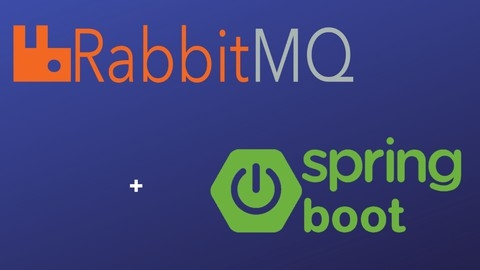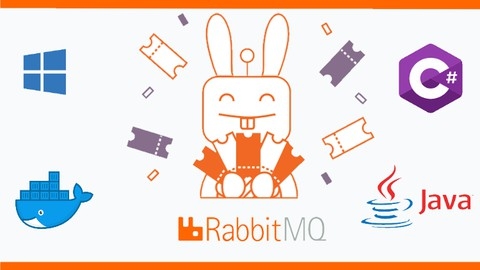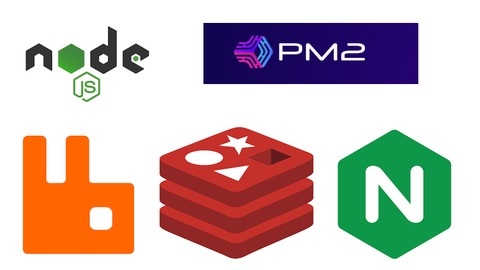If you’re searching for the best RabbitMQ courses on Udemy, you’ve come to the right place.
RabbitMQ is a powerful message broker that enables reliable and scalable communication between applications, but mastering it can be a challenge.
In this blog post, we’ll explore the top RabbitMQ courses on Udemy that will help you unlock the full potential of this versatile tool.
Learn RabbitMQ: Asynchronous Messaging with Java and Spring
You will start by learning the fundamentals of messaging and the AMQP protocol, which RabbitMQ implements.
The course then dives into the core concepts of RabbitMQ, such as exchanges, queues, topics, and bindings.
One of the key strengths of this course is its practical approach.
You will learn how to install RabbitMQ on both Windows and MacOS, and gain hands-on experience with the RabbitMQ management plugin.
This will allow you to create queues, exchanges, and bindings, as well as publish messages directly from the admin interface.
The course then transitions to application development with RabbitMQ.
You will learn how to publish messages using the RabbitTemplate in Spring AMQP, including binary messages.
Additionally, you will configure listeners to receive and process messages from different applications.
A significant portion of the course is dedicated to configuring queues and exchanges with Spring AMQP.
You will learn how to configure direct, topic, fanout, and headers exchanges, as well as create bindings between queues and exchanges.
This knowledge is essential for building robust and scalable messaging systems.
Throughout the course, you will explore real-world scenarios, such as receiving and processing messages from different applications.
This practical approach ensures that you not only understand the theoretical concepts but also gain the skills necessary to implement messaging solutions in your own projects.
Getting Started .NET Core Microservices RabbitMQ
You’ll start by learning the fundamentals of microservices architecture, event buses, and RabbitMQ.
After setting up RabbitMQ, you’ll dive into producers and consumers, exploring how to send and receive messages using RabbitMQ.
The course then guides you through creating a microservice solution from scratch.
You’ll learn how to structure your projects, implement domain models, repositories, and application layers.
The course covers integrating RabbitMQ as an event bus, enabling communication between microservices.
You’ll build two microservices: a banking service and a transfer service.
The banking service handles account management, while the transfer service processes account transfers.
You’ll learn how to publish and consume events between these services using RabbitMQ.
The course also covers advanced topics like dependency injection, MediatR for in-process messaging, and configuring APIs with Swagger.
You’ll learn how to create a presentation layer that communicates with the microservices, allowing you to simulate real-world scenarios.
Throughout the course, you’ll gain hands-on experience with essential tools and technologies, such as RabbitMQ, ASP.NET Core, Entity Framework Core, and MVC.
RabbitMQ : Messaging with Java, Spring Boot And Spring MVC
You’ll start by understanding the fundamentals of the Java Messaging Service (JMS) and RabbitMQ concepts like exchanges and queues.
After installing RabbitMQ, you’ll learn to create queues, publish and consume messages, handle multiple consumers, and work with real-time JSON messages.
The course dives deep into different exchange types - direct, fanout, topic, and headers exchanges.
You’ll learn how to create these exchanges, bind queues to them, publish messages, and consume messages from bound queues.
Quizzes are included to reinforce your understanding.
Moving on, you’ll integrate RabbitMQ with Spring Boot and Spring MVC applications.
You’ll set up projects, configure RabbitMQ, use RabbitTemplate for publishing, and RabbitListener for consuming messages.
This hands-on experience will solidify your skills.
The course also covers deploying RabbitMQ applications to cloud platforms like Pivotal Cloud Foundry (PCF) and Heroku.
You’ll learn to create accounts, provision RabbitMQ services, and deploy Spring Boot and Spring MVC apps using various tools like Spring Cloud, Git, and the Heroku CLI.
Advanced topics like the default exchange and exchange-to-exchange bindings are also covered, giving you a well-rounded understanding of RabbitMQ’s capabilities.
With practical examples, quizzes, and cloud deployment scenarios, this course equips you with the skills to effectively use RabbitMQ for messaging in your Java applications.
You’ll learn to leverage its powerful features like exchanges, queues, and message routing for building robust and scalable systems.
RabbitMQ and Messaging Concepts
You’ll start by learning about the advantages of using a messaging system and common use cases.
The course then dives into the fundamentals of RabbitMQ, covering its installation on Windows and Docker.
You’ll gain hands-on experience with the RabbitMQ management web interface, a powerful tool for monitoring and managing your messaging infrastructure.
The course covers the core elements of messaging systems, including messages, queues, and exchanges.
A significant portion of the course is dedicated to exploring different types of exchanges in RabbitMQ, such as fanout, direct, topic, and headers exchanges.
You’ll learn about their characteristics and use cases through interactive demos and coding exercises using the RabbitMQ C# client library.
The course also covers advanced topics like exchange-to-exchange bindings, alternate exchanges, and the default exchange.
You’ll learn how to implement common messaging patterns like push vs. pull, work queues, publish-subscribe, and request-reply.
Coding demos and exercises reinforce your understanding of these concepts, ensuring you gain practical experience.
The course even covers priority queues, a useful feature for prioritizing important messages.
Throughout the course, you’ll work with both C# and Java samples, making it accessible to developers from different backgrounds.
The syllabus includes extra materials like presentations and all the code samples used in the course.
RabbitMQ In Practice
You’ll begin by learning about queues, exchanges, bindings, and routing keys, which form the core of RabbitMQ’s messaging system.
The course then dives into common messaging patterns like simple queues, work queues, publish/subscribe, and RPC (Remote Procedure Call).
These patterns are essential for building robust and scalable applications with RabbitMQ.
As you progress, you’ll explore advanced features such as custom exchanges, dead letter exchanges, delay scheduling, and data safety mechanisms like transactions and publisher confirms.
These topics will equip you with the knowledge to handle complex messaging scenarios and ensure reliable message delivery.
The course also covers crucial aspects of RabbitMQ’s architecture, including vhosts, policies, lazy queues for memory optimization, and priority queues.
You’ll learn how to configure and manage RabbitMQ instances, including installation, configuration files, and plugins like the web admin interface.
One of the standout features of this course is its focus on distributed brokers and clustering.
You’ll gain hands-on experience with setting up RabbitMQ clusters for scale-out and scale-in scenarios, as well as using shovels and federated exchanges/queues for interconnecting brokers.
Ensuring high availability is a critical concern in messaging systems, and this course covers techniques like mirrored queues and quorum queues to achieve fault tolerance.
You’ll also learn about partitions, which are essential for managing large-scale deployments.
Performance testing and monitoring are essential for maintaining a robust RabbitMQ environment.
The course covers tools like PerfTest and teaches you how to collect metrics, set up alarms, and monitor the memory model.
Security is another important aspect covered in the course, including permissions, authentication, and authorization mechanisms.
You’ll also learn about maintenance tasks like backups, restores, upgrades, and tuning for optimal performance.
RabbitMQ & Java (Spring Boot 3) Bootcamp - Basic To Advanced
You will start by learning the basics of messaging systems and RabbitMQ’s core concepts.
The course covers the installation process for different operating systems like Windows, Linux, and Mac, as well as using Docker.
Once you have RabbitMQ set up, you will dive into writing code using Java and Spring Boot.
The course covers various queue types in RabbitMQ, such as fanout, direct, and topic exchanges.
You will learn how to produce and consume JSON messages, customize the JSON format, and work with multiple consumers for each queue.
Error handling is an essential aspect covered in the course.
You will learn about the Dead Letter Exchange (DLX) and Time to Live (TTL) mechanisms to handle errors and expired messages.
The course also covers retry mechanisms for direct and fanout exchanges, making it easier to handle consumer exceptions.
The course introduces you to RabbitMQ’s REST API, allowing you to manage and monitor your RabbitMQ instance programmatically.
You will learn how to sweep dirty queues and explore RabbitMQ plugins like the Delayed Message Exchange.
Moving forward, the course covers advanced concepts like scheduling consumers, consumer prefetch, message ordering, and handling multiple message types with a single queue.
You will also learn about the Consistent Hash Exchange and implementing a single active consumer pattern.
The course delves into reliable publishing and request/reply patterns, as well as creating RabbitMQ structures like exchanges and queues from Java code.
It also compares RabbitMQ with Apache Kafka, another popular messaging system.
Additionally, the course introduces you to RabbitMQ Stream, a new streaming platform for RabbitMQ.
You will learn about offset tracking, single active consumer on streams, and the Super Stream concept.
The course covers working with JSON messages in both Stream and Super Stream modes.
Throughout the course, you will work on practical projects and exercises to reinforce your understanding of the concepts.
The course provides source code and scripts for you to follow along and practice.
Node JS Cluster with PM2, RabbitMQ, Redis and Nginx
The course starts with an introduction to Node.js clustering, explaining why it’s important and how to create your first clustered Node.js application using the built-in cluster module.
You’ll learn how to load test your clustered application to see the performance benefits.
The course then dives into PM2, a process manager for Node.js applications.
You’ll learn how to run an Express.js application using PM2 and explore communication between master and child processes.
One key topic is using PM2 and RabbitMQ for communication between master and child processes.
You’ll get hands-on experience with this powerful combination.
The course also covers the RabbitMQ web interface for monitoring and management.
Redis, a popular in-memory data store, is covered in depth.
You’ll learn how to use Redis as a cache with an Express.js REST API running on PM2.
The course also explores using Redis as a publisher and subscriber with PM2.
Nginx, a high-performance web server and reverse proxy, is another important topic.
You’ll learn how to use Nginx as a reverse proxy and load balancer for your Node.js applications.
Throughout the course, you’ll work with practical examples and real-world scenarios, ensuring you gain hands-on experience with these technologies.
Learn RabbitMQ: In-Depth Concepts from Scratch with Demos
The course starts by introducing you to the fundamental concepts of message queueing and message brokers, specifically focusing on RabbitMQ’s implementation of the AMQP protocol.
You’ll learn how to set up RabbitMQ on both Windows and Linux environments, as well as how to manage users and virtual hosts through the RabbitMQ Management Console.
The course dives deep into RabbitMQ’s core features, such as exchanges (fanout, direct, and topic), asynchronous communication patterns, and message publishing demos.
One of the standout topics is RabbitMQ clustering, where you’ll learn about disc and RAM nodes, resource sharing, and transparent queues within a cluster environment.
The course also covers advanced concepts like federation and shoveling, which allow you to interconnect multiple RabbitMQ instances across different networks or data centers.
High availability and failover mechanisms are crucial in production environments, and this course dedicates a section to understanding master and mirror queues, as well as demonstrating queue failover scenarios.
You’ll also learn how to automate RabbitMQ management operations using the command-line tool and REST APIs.
Throughout the course, you’ll gain hands-on experience with PyCharm, an integrated development environment for Python, and work on building publisher and consumer applications that interact with RabbitMQ.
The course is packed with demos that reinforce the concepts and provide a practical understanding of RabbitMQ’s capabilities.
RabbitMQ Python
The course starts by introducing you to RabbitMQ and guiding you through the setup process.
You’ll learn the basics of RabbitMQ, including how to establish basic communication using the default exchange.
Next, you’ll dive into broadcasting messages using the fanout exchange.
This involves working with temporary queues and understanding exclusivity.
You’ll apply what you’ve learned by building a centralized alert system.
The course then covers selective routing with the direct exchange, allowing you to direct messages to specific queues.
Again, you’ll reinforce your understanding through a lab and another iteration of the centralized alert system assignment.
Moving on, you’ll explore the topic exchange for pattern-based routing of messages.
This powerful concept enables you to handle more complex routing scenarios.
The course also touches on binding loss and how to handle it effectively.
Reliable communication is a crucial aspect covered in-depth, ensuring your messages are delivered reliably.
You’ll learn techniques for achieving this and put them into practice through a dedicated lab.
Finally, the course dives into the concept of Remote Procedure Call (RPC), enabling you to make remote calls between applications using RabbitMQ as the communication layer.
You’ll implement an RPC system in a lab exercise.
Throughout the course, you’ll work on building a centralized alert system, incrementally adding new features as you progress through the different concepts and techniques.
Spring Boot 3 + RabbitMQ Course - The Practical Guide
You’ll start by learning the core concepts and architecture of RabbitMQ, and then set it up using Docker.
Next, you’ll dive into building Spring Boot applications that produce and consume messages from RabbitMQ.
You’ll learn how to configure RabbitMQ in your Spring Boot app and create producers to send both string and JSON messages.
You’ll also build consumers to receive these messages.
The course then explores event-driven architecture and how it works with the advantages it offers.
You’ll apply this knowledge by building an event-driven microservices system using Spring Boot and RabbitMQ.
This involves creating three microservices - OrderService, StockService, and EmailService - and configuring RabbitMQ in each.
You’ll create a RabbitMQ producer in the OrderService to send order placement events.
The StockService will consume these events to update stock levels.
The OrderService will also send events to an email queue that the EmailService consumes to trigger email notifications.
Throughout the course, you’ll use tools like IntelliJ IDEA, Docker, and build REST APIs.










